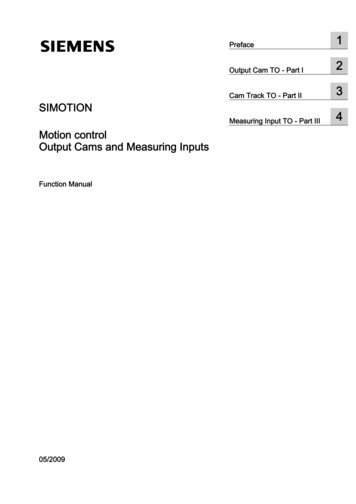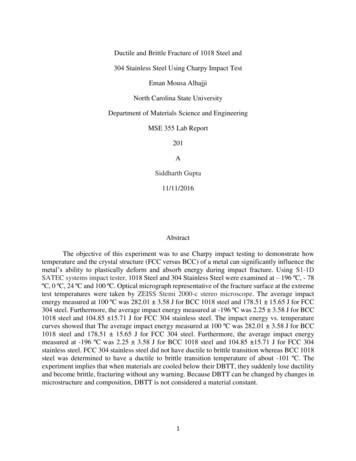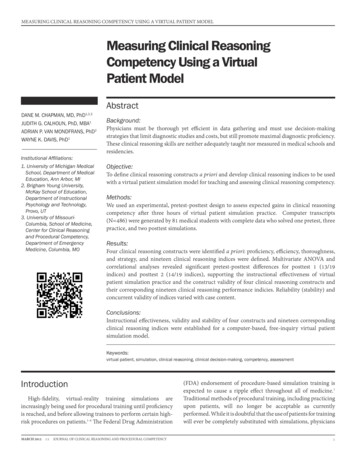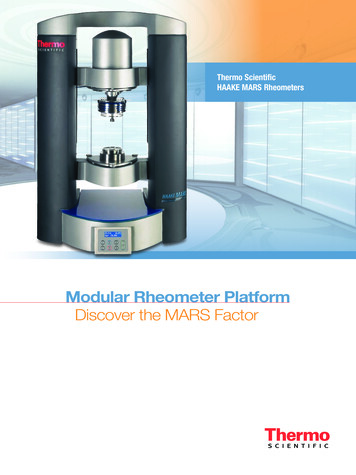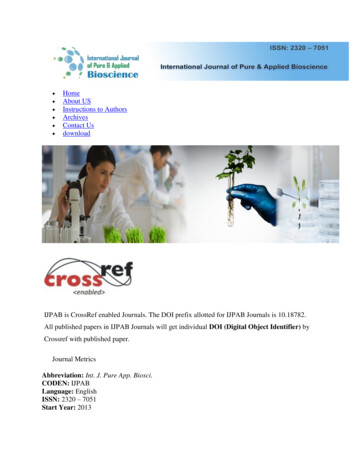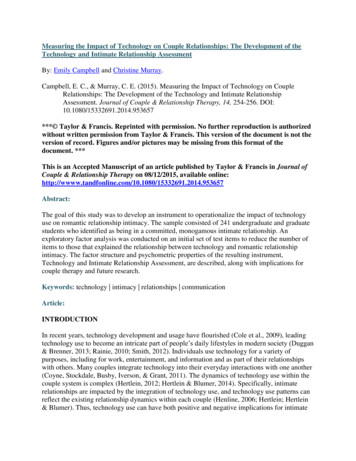
Transcription
Measuring the Impact of Technology on Couple Relationships: The Development of theTechnology and Intimate Relationship AssessmentBy: Emily Campbell and Christine Murray.Campbell, E. C., & Murray, C. E. (2015). Measuring the Impact of Technology on CoupleRelationships: The Development of the Technology and Intimate RelationshipAssessment. Journal of Couple & Relationship Therapy, 14, 254-256. DOI:10.1080/15332691.2014.953657*** Taylor & Francis. Reprinted with permission. No further reproduction is authorizedwithout written permission from Taylor & Francis. This version of the document is not theversion of record. Figures and/or pictures may be missing from this format of thedocument. ***This is an Accepted Manuscript of an article published by Taylor & Francis in Journal ofCouple & Relationship Therapy on 08/12/2015, available 1.2014.953657Abstract:The goal of this study was to develop an instrument to operationalize the impact of technologyuse on romantic relationship intimacy. The sample consisted of 241 undergraduate and graduatestudents who identified as being in a committed, monogamous intimate relationship. Anexploratory factor analysis was conducted on an initial set of test items to reduce the number ofitems to those that explained the relationship between technology and romantic relationshipintimacy. The factor structure and psychometric properties of the resulting instrument,Technology and Intimate Relationship Assessment, are described, along with implications forcouple therapy and future research.Keywords: technology intimacy relationships communicationArticle:INTRODUCTIONIn recent years, technology development and usage have flourished (Cole et al., 2009), leadingtechnology use to become an intricate part of people’s daily lifestyles in modern society (Duggan& Brenner, 2013; Rainie, 2010; Smith, 2012). Individuals use technology for a variety ofpurposes, including for work, entertainment, and information and as part of their relationshipswith others. Many couples integrate technology into their everyday interactions with one another(Coyne, Stockdale, Busby, Iverson, & Grant, 2011). The dynamics of technology use within thecouple system is complex (Hertlein, 2012; Hertlein & Blumer, 2014). Specifically, intimaterelationships are impacted by the integration of technology use, and technology use patterns canreflect the existing relationship dynamics within each couple (Henline, 2006; Hertlein; Hertlein& Blumer). Thus, technology use can have both positive and negative implications for intimate
partners, although these implications vary based on relational dynamics (Hertlein, 2012; Pettigrew, 2009). Despite the growing recognition of the impact of technology on intimaterelationships, there are few instruments created to measure the impact of technology on intimaterelationship dynamics (Hertlein & Blumer). Thus, the purpose of this study was to develop aninstrument intended to measure the impact of technology use on romantic relationship intimacythat is uniquely different form existing instruments.LITERATURE REVIEWTechnology advancements have changed technology usage trends. As one example, about 75%of individuals in the United States are connected to the Internet (Rainie, 2010). Of thoseindividuals who are online, about 92% choose e-mail as a primary source for communicatingwith others (Purcell, 2011a). In addition, an estimated 83% of individuals online between theages of 18 and 29 have at least one social networking account (Duggan & Brenner, 2013).Another example of technological devices that have proliferated in the U.S. population is cellularphones (including smartphones). In fact, an estimated 85% of North Americans own a cell phone(Smith, 2012), and about 1 in 3 (34%) households only use cell phones (i.e., they do not have alandline; Blumberg, Luke, Ganesh, Davern, & Boudreaux, 2012). Text messaging has become anincreasingly popular form of communication, with 31% of individuals preferring it to phone calls(Smith, 2011). The majority of cell phones sold today also include access to the Internet, as wellas numerous downloadable applications used for a variety of purposes (Purcell, 2011b). TheInternet and cell phones are but two examples of the many technologies that have changed thelives and relationships of people in modern society.Technology and Romantic RelationshipsThe impact of technology on modern relationships is just beginning to be studied throughresearch and theoretical scholarship. In general, technology use has changed human interactionsby blurring the boundaries and rules for interacting with one another, ultimately changing theprocesses for initiating, maintaining, and terminating intimate relationships (Hertlein, 2012;Hertlein & Blumer, 2014). Inherently, technology is another aspect that must be navigated bycouples (Perry & Werner-Wilson, 2011; Pettigrew, 2009).POSITIVE IMPLICATIONSConjoint use of technology within romantic relationships can have positive effects on intimacy(Henline, 2006). Conjoint use occurs when couples have a shared intention of using technologyto connect with one another that results in quality time spent together (Henline). For example,couples in long distance relationships may set a time to talk via visual video chat system at theend of each day. Similarly, couples can conjointly engage with entertainment (e.g., television) tocreate more opportunities for intimate moments (i.e., laughing, crying, and physical touch).Interactive forms of technology create opportunities for couples to enhance their closeness andconnection (Coyne et al., 2011; Valentine, 2006). Text messaging is the most commonly usedtechnology by couples to communicate to one another (Coyne et al.). Many couples prefertexting over phone calls because of the privacy it affords (i.e., lack of verbal noise; Petti- grew,
2009). In fact, Coyne et al. found 75% of couples’ text messages to one another are used toprivately communicate affection to one another. Other examples of technology used to enhanceintimacy include couples using e-mail and visual video chat systems to stay connected. Couplesin which partners use interactive technology to connect report more confidence, opencommunication, emotional connection, and positive interactions with their partners (Johnson,Haigh, Becker, Craig, & Wigley, 2008; Neustaedter & Greenberg, 2012).Last, technologies have created additional spaces for individuals to pursue intimacy, includingchat rooms, dating sites, virtual worlds, and social networking sites (SNS). Dating sites, SNS,and virtual worlds are attractive ways that individuals are now connecting with others when insearch of new relationships (Valentine, 2006). In particular, individuals with social anxietyreport feeling safer to disclose personal information and to show their true self with otherindividuals when the interactions are mediated through a technology medium (Henline, 2006).NEGATIVE IMPLICATIONSOf course, technology has created new obstacles for couples to overcome (Hertlein & Stevenson,2010; Hertlein & Webster, 2008). Technology is appealing, accommodating, accessible, andaffordable (Hertlein & Stevenson) and grants easy access to gratifying activities. Althoughtechnology is valued for these features, it also can undermine intimate interactions for couples(Hertlein & Stevenson; Hertlein & Webster). Partners’ investment in technology absorbs timethat otherwise could be invested in their relationship (Hen- line). Intimacy is negatively impactedwhen a person consistently chooses to use technology for individual fulfillment instead ofspending time with their partner (Henline). For some individuals, this occurs unconsciously, andfor others it is an intentional escape from stressors (Henline; Hertlein, 2012). For example, anongaming partner may feel lonely and neglected because of the time gaming took away fromthe romantic relationship, as well as resentful because of the intimate connections the gamingpartner made with other gamers (Coyne et al., 2012). Similarly, Bergner and Bridges (2002)found that partners of frequent online pornography users feel betrayed, disrespected, and lesssexually desirable and have an overall decrease in commitment and intimacy within theirromantic relationship. Thus, the emotional investments individuals make into technology cancause distress in romantic relationships if there are not appropriate boundaries in place (Hertlein& Webster).Likewise, the Internet is a forum through which committed partners can pursue extrarelationalintimacy with other people (Millner, 2008). The anonymity of the Internet can foster deceitfulbehaviors (Hertlein & Steven- son, 2010) because individuals are more likely to do things on theInternet (e.g., flirt, engage in cybersex, and lie) that they would not ordinarily do in real life(Rumbough, 2001). Perhaps, then, it is not surprising that approximately one-third (33%) ofdivorce cases have been associated with an Internet infidelity (Mileham, 2007).Similarly, SNS can contribute to feelings of discontentment in romantic relationships. Selfcomparison is a negative byproduct of SNS, when people compare the positives and negatives oftheir relationship to others’ relation- ships (Henline, 2006). This can cause conflict anddiscontentment within one’s own relationship (Hand, Thomas, Buboltz, Deemer, & Buyanjargal,2013). In addition, SNS provide an array of alternative relationship options, detracting efforts
toward mending the current relationship, especially if that relationship is under a high level ofdistress. Romantic partners with a high investment in technology may be infiltrated with imagesthat are unrealistic, unconsciously fostering unrealistic expectations for their significant partnerand the romantic relationship (Zurbriggen, Ramsey, & Jaworski, 2011).The ease of connecting through technology can create enmeshed relationships. This is considereda negative implication when too much connecting inadvertently decreases the autonomynecessary for healthy romantic relationships (Duran, Kelly, & Rotaru, 2011). For example,romantic partners may start expecting their partners to always be available or to respondimmediately to communication, such as text messages. On the other hand, partners mayimpulsively respond to emotionally triggering stimuli. When technology is used impulsively,meaningful interactions between couples may decrease (Scott, Mottarella, & Lavooy, 2006).Finally, the absence of nonverbal communication via technology can increase misunderstandingsbetween partners (Pettigrew, 2009). With the exception of video chat programs, the lack ofnonverbal (i.e., tone of voice, facial expressions, body language) communication cues can causepartners to misinterpret what is being communicated (Pettigrew, 2009). Similarly, technologymay foster jealousy and mistrust (Papp, Danielewicz, & Cayemberg, 2012). Technologyprovides other ways in which jealous partners can check up on one another (Dijkstra, Barelds, &Groothof, 2010). For instance, technology serves as another vessel for dominating and violentpartners to exert more control over their romantic partners (Schnurr, Mahatmya, & Basche,2013). In sum, existing research demonstrates a range of potential positive and negative impactsof technology on couples’ intimate relationships.Technology and Couple CharacteristicsCouples’ patterns of technology use are influenced by several variables, including theirrelationship duration, status, and satisfaction, as well as individual age (Coyne et al., 2011).Couples in long lasting (i.e., postdating status) romantic relationships use technology less tocommunicate with their romantic partners. However, when these couples use technology, theyare more likely to communicate affections (Coyne et al.). In comparison, couples in shorter-termrelationships are more likely to use technological devices impulsively to discuss confrontationaland hurtful messages (Coyne et al.). As a result, couples that use technology to communicateaffectionately foster more intimacy and are more satisfied with their romantic relationships(Coyne et al.). Another important characteristic is age, which may affect the amount oftechnology use within romantic relationships (Hanson, Drumheller, Mallard, McKee, &Schlegel, 2010; Smith, Rainie, & Zickuhr, 2011). Specifically, younger couples are more likelyto use technology to communicate with partners and more likely to demonstrate other destructivepatterns of communication (i.e., communicate serious, hurtful, or confrontational issues) (Coyneet al.). As such, existing research exhibits several characteristics of couples that influence theirpatterns of technology use with one another.A Framework for Technology, Intimacy, and Romantic RelationshipsThe Couple and Family Technology Framework (CFT Framework) is a framework forunderstanding technology in couple and family life (Hertlein
& Blumer, 2014). The integration of technology into U.S. lifestyles have changed the structures,boundaries, and processes within the relationship system. As human interactions are altered,boundaries and rules for commitment and intimacy are blurred (Hertlein & Blumer, 2014).The CFT Framework integrates three theoretical perspectives: family ecology, structuralfunctional, and interaction constructionist (Hertlein & Blumer, 2014). First, the ecologicalperspective emphasizes how changes to humans’ surrounding environment (i.e., technologyadvancements) influence smaller systems like couples and families. The ecological perspectiveIncludes seven elements (i.e., Seven As: accessibility, affordability, anonymity, acceptability,approximation, ambiguity, accommodation) to describe the ways in which the environment caninfluence individual and relational systems. Ecological influences initiate two types of change torelationship systems: (a) change to the structure (i.e., organization) of relationships and(b) change to the process of relationships. Structural changes, as identified by the structuralfunctional perspective, inherently redefine each system’s set of rules, boundaries, and roles inrelationships. Changes to relationship processes emerge from the interaction constructionistperspective. Human interactions are altered because of technology advancements. Thus,relationship development and intimacy are redefined because interactions for initiating,maintaining, and terminating relationships have expanded to include interactions throughtechnology (Hertlein, 2012; Hertlein & Blumer, 2014 [Figure 4.1]).As a result, couples’ relationship commitment and intimacy are affected by technology (Hertlein,2012; Hertlein & Blumer, 2014). In reference to the CFT Framework, relationship commitmentand intimacy are products of relationship maintenance. Relationship intimacy emerges throughcommunicative interactions and is redefined when interactional processes are mediated throughtechnology. Thus, intimacy can be enhanced through technology use, such as for the initiationand maintenance of romantic relationships (Hertlein; Hertlein & Blumer). Also, intimacy can behindered when technology is used for terminating relationships, fostering deviant behaviors, ordetracting time from one’s intimate partner (Hertlein & Stevenson, 2010; Hertlein & Webster,2008; Millner, 2008).Assessing Intimacy and Technology UseThe interconnections between technology use and romantic relationship intimacy are evident(Coyne et al., 2011, 2012; Hertlein, 2012; Hertlein & Blumer, 2014; Hertlein & Stevenson, 2010;Hertlein & Webster, 2008; Neustaedter & Greenberg, 2012). The ability to broadly generalizethe results of existing research, however, is limited due to the assortment of assessment strategiesthat researchers have used to study the impacts of technology on romantic relationships. To date,most assessment strategies are study-specific questionnaires for which there are limited dataregarding the psychometric properties of the instrumentation. In fact, only two instruments forassessing the impact of technology on couples and families exist: Ecological ElementsQuestionnaire and Technological Genogram (Hertlein & Blumer, 2014). The EcologicalElements Questionnaire is a structured assessment tool that measures an individuals’ technologyuse by focusing on the ecological influences of the Seven As. In contrast, the TechnologicalGenogram is a semistructured interview tool used to explore the dynamics and patterns oftechnology use at the individual level, as well as at the intergenerational level (Hertlein &Blumer).
Neither instrument, however, accounts for a structured assessment that measures the interactionbetween individuals’ perception of their technology use and how their technology use isperceived to impact their romantic relationship intimacy. Therefore, to enhance future research, aneed exists for a psychometrically sound instrument to measure the impact of technology use onromantic relationship intimacy. In the present study, the researcher aimed to meet this need bydeveloping the Technology and Intimate Relationship Assessment (TIRA).METHODThe following research questions guided this study: What are the psychome- tric properties (i.e.,underlying factor structure, internal consistency coeffi- cients, and item-scale correlations) of thefinal version of the TIRA total scale and any identified subscales? What are the relationshipsbetween TIRA total scale and subscale scores and (a) relationship satisfaction, (b) relationshipstatus, (c) relationship duration, and (d) age?Scale DevelopmentITEM GENERATIONThe first step in developing the scale included creating an initial item pool, which was developedbased on existing research, primarily the Multitheoretical Model (Hertlein, 2012), which hassince been updated to the CFT Framework (Hertlein & Blumer, 2014), and the clinicalexperience of the researchers. The researchers aimed to include all possible item choices thatrepresented both positive and negative impacts of technology on romantic relationship intimacy.A four-phase iterative process of reviewing, revising, and refining the items in the initial poolresulted in a total of 47 test items. Next, the item pool was reviewed by a panel of individualswho had content knowledge on the topic of couple relationships. Four mental healthprofessionals reviewed the survey (i.e., two master’s-level professional counselors and twodoctoral students in a Council for Accreditation of Counseling and Related EducationalPrograms [CACREP]-accredited counselor education pro- gram). Three reviewers were women,and one was a man. Each reviewer provided feedback on the clarity of questions and formatting,as well as content and items that might be missing related to this topic. The reviewers’ feedbackwas used to revise and finalize the items in the pool.INSTRUMENTATIONThe instrumentation included a demographic and background questionnaire and the 47-item poolfor the TIRA. The demographic questionnaire assessed participants’ age, relationship duration,number of children, distance apart (if in a long-distance relationship), income, current livinglocation and arrangements, gender, ethnicity, education, relationship status, and experiences incouples counseling. Relationship satisfaction was assessed with a single item (i.e., “Overall, howsatisfied are you with your relationship with your partner?”), which participants rated on a 7point Likert scale ranging from 1 (“very dissatisfied”) to 7 (“very satisfied”). To assess forgeneral pat- terns of technology use, a single item was used (i.e., “First, please check the box toindicate which of the following technologies you use on at least a weekly basis. Then, for the
technologies you checked, please indicate about how many hours per day you use each identifiedtechnology.”), in which participants had the following technology device options to choose from(e.g., computer, smartphone, television) and the following technology service options to choosefrom (the Internet, online gaming, e-mail, social networking sites, text messaging, television,Internet television, Internet radio, Internet chat rooms, a blog I write, a blog I follow, visualvideo chat service). The initial item pool for the TIRA was composed of 47 items with an overallninth-grade Flesch-Kincaid readability level. The 47 test items were assessed on a Likert scaleranging from 1 (“strongly disagree”) to 5 (“strongly agree”). A sixth response option (notapplicable) was provided for those participants who did not believe that the item applied to them.Data Collection and Participant Recruitment ProceduresFollowing institutional review board (IRB) approval, the electronic survey was distributedthrough an Internet-based survey-hosting platform. Participants were required to read andindicate agreement with the informed con- sent document before they could access the onlinesurvey. Survey responses were anonymous. Participants entered the e-gift card drawing by usinga survey link that was separate from the survey link with their responses to the main instrument.The sample was recruited from a population of under- graduate and graduate students at a midsized (i.e., approximately 18,000 students) public university in the southeastern United States. Inorder to achieve a sufficient sample size, the researchers received a list of 3,000 randomlyselected undergraduate and graduate students’ e-mail addresses from the university institutionalresearch office. It was not possible to determine which students met the relationship statusinclusion criteria (i.e., they were in a committed, monogamous relationship) for studyparticipation, because the institutional research office does not have records of students’relationship statuses. Thus, of the 3,000 prospective participants, whether or not they were in acommitted, monogamous relationship, received a total of three recruitment e-mails, whichprovided the link to the electronic survey. As such, the final sample should be considered aconvenience sample.Data AnalysesAn exploratory factorial analysis (EFA) was used to reduce the initial item pool to a concise andtheoretically consistent final version of the TIRA. The EFA analyzed the underlying factorstructure of the items without prior knowledge of the number of factors or the loadings on eachfactor for that particular observed variable (Kim & Mueller, 1978). Researchers soughtconsultation with a statistician to ensure appropriate implementation and interpretation of theEFA. Once the EFA results were interpreted and the final TIRA was developed, its internalconsistency and item-scale correlations were calculated to demonstrate the instrument’spsychometric properties. Then, to address research question 2, correlation and one-way analysisof variances (ANOVAs) were performed to examine the relationships among the TIRA total andsubscale scores and the key demographic and background variables as a preliminary measure ofthe TIRA’s validity.RESULTSDescription of the Sample
Of the 3,000 prospective participants who received an e-mail, 319 (10.6%) responded to at leastsome part of the survey. Of these, 174 (55%) of respondents resulted from the first recruitment email, 94 (30%) from the second, and 49 (15%) from the third. Only 243 of the 319 participantscompleted the online survey, resulting in an 8.1% response rate of the total sample. Another 18participants were dropped from the study as a result of excessive unanswered survey questions(missing data at random; Acock, 2005) resulting in 225 participants included in the analyses.One hundred seventy-seven (78.7%) participants were women, 45 (20%) were men, and 3(1.3%) identified as “other,” 2 of which specified that they were transgender. Of the 177 womenparticipants, 165 (93.2%) reported the gender of their partners as men, and 12 (6.8%) womenreported the gender of their partners as women. Of the 45 men participants, 38 (84.4%) reportedthe gender of their partners as women, and 7 (15.6%) reported the gender of their partners asmen. Of the 2 transgender participants, both reported the gender of their partners as women.Most participants were Caucasian (n 176; 78.2%), followed by African American (n 32;14.2%), Asian (n 7; 3.1%), Latino/Hispanic (n 12; 5.3%), Native American (n 3; 1.3%),and other (n 9; 4%). Participants were allowed to identify with more than one ethnicity.Participants’ ages ranged from 18 to 78 years old with a mean of age of 27.9 years (SD 10.67).About one-half of the participants identified as being in an exclusively dating relationship (n 107, 47.6%), with the remaining participants identifying as being in casual dating relationships(n 7, 3.1%), engaged (n 25, 11.1%), married (n 73, 32.4%), domestic partnerships (n 11,4.9%), and other (n 2, 0.9%). The range of relationship duration consisted of a little less than 1month to 37 years (444 months), with a mean of 5.4 years (SD 7.1). Most participantsidentified as being very satisfied in their romantic relationship (n 132, 58.7%), followed bysatisfied (n 64, 28.4%), somewhat satisfied (n 12, 5.3%), neutral (n 6, 2.7%), somewhatdissatisfied (n 6, 2.7%), dissatisfied (n 1, 0.4%), and very dissatisfied (n 4, 1.8%). Inviewing these responses along the response scale, the sample’s mean score was 6.3 (SD 1.2) ona scale from 1 to 7, indicating a high level of satisfaction among the sample. Of the 225participants included in the study, 204 participants (90.7%) reported using computer devices, 165(73.3%) smartphone technology devices, and 139 participants (61.8%) reported using television.In addition, 81 participants (36%) reported used e-mail technology service, 225 (100%) Internet,35 (15.6%) online gaming, 179 (79.6%) Facebook, 67 (29.5%) use other social network, 204(90.7%) text messaging, 81 (36%) Internet television, 64 (28.4%) Internet radio, 16 (7.1%) blog Iwrite, 26 (11.6%) blog I follow, 7 (3.1%) chat rooms, 38 (16.9%) video chat service, and 3participants (1.3%) reported using other technology services.Psychometric Properties of the TIRAResearch Question 1: What are the psychometric properties (i.e., underlyingfactor structure, internal consistency coefficients, and item-scale correlations) ofTIRA total scale and any identified subscales?The EFA process resulted in a final instrument with 22 items containing two subscales. TheIntimacy-Enhancing Subscale contains 11 items that describe ways the participants’ use oftechnology is perceived to positively influence their romantic relationships. The IntimacyReducing Subscale includes 11 items that describe ways the participants’ use of technology is
perceived to negatively influence their romantic relationships. Items that demonstrated factorloading coefficients less than 0.30 were suppressed during data analyses (Costello & Osborne,2005) and did not load on factors. Thirty-nine items remained. Test items that demonstratedadequate factor loadings but did not conceptually make sense with other items that loaded on theintended factors of intimacy enhancing and intimacy reducing also were deleted. Items thatcrossloaded on both factors were deleted to minimize shared variance (Costello & Osborne,2005). The remaining 22 items demonstrated moderate to strong factor loadings as evidenced byfactor loadings between 0.40 to greater than 0.70 (Costello & Osborne, 2005). Table 1 providesthe factor loadings for each of the scale’s items.Cronbrach’s alpha coefficients were used to assess the internal consistency of the TIRASubscales. The analyses revealed a Cronbrach’s alpha of .860 for factor 1 (Intimacy-Enhancingscale items). Similarly, the analyses revealed a Cronbrach’s alpha of .826 for factor 2 (IntimacyReducing scale items).
Item–subscale correlations were calculated. Items on the Intimacy- Enhancing Subscale resultedin moderate to high correlations ranging from 0.487 to above 0.700. In contrast, items thatloaded moderate to high on Intimacy-Enhancing Subscale demonstrated low correlations on theIntimacy- Reducing Subscale, ranging from 0.056 to 0.303. Similarly, Intimacy-ReducingSubscale items demonstrated moderate to high correlations ranging from 0.522 to just below0.70. However, these subscale items demonstrated low correlations with the Intimacy-EnhancingSubscale, ranging from 0.031 to 0.294.Preliminary ValidityResearch Question 2: What are the relationships between TIRA subscale scores and (a)relationship satisfaction, (b) relationship status, (c) relationship duration, and (d) age?The means of the TIRA subscale scores were correlated with relationship satisfaction,relationship duration, and age. TIRA items were measured on a Likert scale of 1 (“stronglydisagree”) to 5 (“strongly agree”). Scores for each of the TIRA’s subscales can range from 11 to55 when all questions are answered. Higher Intimacy-Enhancing Subscale scores represent thatparticipants view technology as more positively enhancing their romantic relationship intimacy,and higher Intimacy-Reducing Subscale scores represent that participants view technology asmore negatively reducing romantic relationship intimacy. “Not applicable” responses were notcalculated as part of the subscale scores. Participants that responded Not Applicable on 20% ormore subscale test items were dropped from further analyses. For those participants with some,but less than 20% of, Not Applicable responses, subscale averages were calculated to account formissing items. Participants’ mean scores for the Intimacy-Enhancing Subscale ranged from 1 to4.55. Average scores for the Intimacy-Reducing Subscale ranged from 1 to 5.
TIRA subscale scores and participant relationship satisfaction scores were correlated. Scores forrelationship satisfaction could range from 1 (“very dissatisfied”) to 7 (“very satisfied”). Apositive, weak, but not statistically significant correlation emerged between Intimacy-EnhancingSubscale scores and relationship satisfaction
distress. Romantic partners with a high investment in technology may be infiltrated with images that are unrealistic, unconsciously fostering unrealistic expectations for their significant partner and the romantic relationship (Zurbriggen, Ramsey, & Jaworski, 2011). The ease of connect




